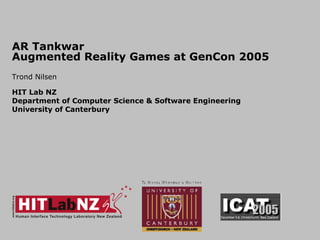Icat2005
- 1. AR Tankwar Augmented Reality Games at GenCon 2005 Trond Nilsen HIT Lab NZ Department of Computer Science & Software Engineering University of Canterbury
- 2. AR Games Most offered systems are tech demos, impractical outside the laboratory, or proofs of concept. Interest in gaming and entertainment apps that are playable now, or in the very near future How can we learn about good game design for AR? Lessons learned from research Interaction metaphors and theory Information Visualisation (for game data) CSCW Social Interaction Lessons learned from the act of designing Iterative game design Better understanding of the constraints of the medium Lessons learned from watching Player feedback Observation Where do we start? With something thatâs known to work in other environments
- 3. Tabletop Strategy games Turn based strategy games Game conflict resolved through rules, dice and player consensus Often use armies of miniatures Strong modelling component Have problems suitable for solution using AR Complexity â players unwilling to manually resolve complex rules Visualisation â cotton wool and painted models only go so far Information flow â practicality forces much game information to be publicly visible (eye of god effect)
- 4. Computerised Strategy games First built by tabletop war game enthusiasts wanting more complex game systems During 1990s evolved into distinct computer game styles Turn based strategies (more serious, less popular) Real-time strategy (very popular) Dune 2 / Command & Conquer Warcraft / Starcraft Age of Empires (etc)
- 5. What could work in AR? From the physical game Extremely Social Free physical interaction Artistic physical representations Abstracted game entities â Eye of Godâ view From the computer game Artificial intelligence Simulated systems Rich visualization and content Complex game rules Information intensive Hybridise
- 6. AR Tankwar Multi-player tabletop real-time strategy game Two players collaborate or compete to destroy enemy vehicles and capture map objectives Video See Through AR AR-Toolkit Magic Lens based Interaction See-through selection tool attached to game pad. Focus / Context visualization Practical for recreational play
- 7. Evaluation - Difficulties Most game evaluations are skin-deep at best. Evaluation Observe player behaviour Collaborative behaviours Ease of use / interface problems Questionnaires â subjective responses Enjoyment Engagement (Flow questionnaires) Measures of collaboration Stress, frustration, etc Interviews Following a game session Discuss problem cases and particular occurrences from playerâs perspective Explore ideas for improvement Problems Objective measures do not easily characterize player enjoyment Possibility space is vast, so game design decisions have large impact Games exhibit emergence â the whole is greater than the sum of the parts. Thus, decomposition into laboratory tasks is deficient â WOW!!â factor. New technology may lead to over-enthusiastic responses.
- 8. Initial study â GenCon 2005 (Indianapolis - 18-21 Aug) Demonstration - GenCon North Americaâs largest tabletop games convention (25-30,000 attendees) 3000+ spectators Over 300 players played Tankwar for 5-10 minutes. Almost none had any previous exposure to AR General points: Observed wide range of ability to learn interface â some took seconds, others had great difficulty Hardware caused problems Heavy and uncomfortable Wide range of player heads â from children to grandparents Positive response, sometimes contradictory â hard to see whatâs happening, uncomfortable headset, map keeps flipping out, I love it!â Players required time to get used to AR Most comments related to technical problems of some kind
- 9. GenCon - Questionnaire Collected 230 questionnaire responses How comfortable were you while playing? (1=Uncomfortable, 5=Comfortable) mean = 2.93, Ï = 1.09 Could you easily tell what was going on? (1=Hard, 5=Easy) mean = 3.35, Ï = 1.15 How easily could you control the game? (1=Hard, 5=Easy) mean = 3.34, Ï = 1.63 Cost notwithstanding, how willing would you be to play multi-player tabletop games augmented using headsets?(1=Unwilling, 5= Willing) mean = 4.08, Ï = 1.07 General contradiction: People had a lot of problems, yet they were very enthusiastic Why? Wow Factor? Recognition of potential? (Clouded by immaturity of tech)
- 10. Observations Noise in tracking slows use of lens interface Hard to point and click on targets Fast and precise movements are impractical Game speed should be slow or turn-based AR interface requires more time to use. Less time pressure makes social interaction more likely Too much game data conceals physical world Players feel dislocated from real world Interferes with non-verbal cues Simple graphics are better Limits on quality of HMDs Text is hard to read Graphical details are lost Abstract, colourful representations seem to work best HMDs limit, but do not inhibit player to player interaction HMDs limit some non-verbal communication â particularly eyes Players in face to face AR seem quite willing to interact socially during play Exchanging challenges, taunts, and strategies Particularly more experienced players Able to play and complete difficult collaborative scenarios
- 11. Some guidelines for tabletop AR game design Hardware remains the big limit Discomfort Low quality displays Tether Tracking problems So, design games that are Use mostly static physical interface Few time constraints Involve social interaction High level of abstraction Availability of computational power to enhance simple game designs Emergent game play In short: Keep hardware requirements as simple as possible (otherwise, your game wonât leave the lab).
- 12. Whatâs next Comparative study of play Players will play AR Tankwar A âbest-practiceâ PC RTS equivalent (using same rules) A âbest-practiceâ table-top game with counters (using same rules, modified for turn-based) Evaluation through Questionnaire Interview Measures of behaviour (tasks ratio, messages, gestures, gaze) Measures of performance (time taken, kill/loss ratio, kill/capture ratio) Data yet to be analysed Examination of specific issues Game play highlights areas where collaboration and interaction in AR is insufficiently understood Lens selection (multi-selection) Tools to support shared awareness Nature of HMD effect on inter-personal communication Fixed / scrollable map view More games â Liteâ AR games













